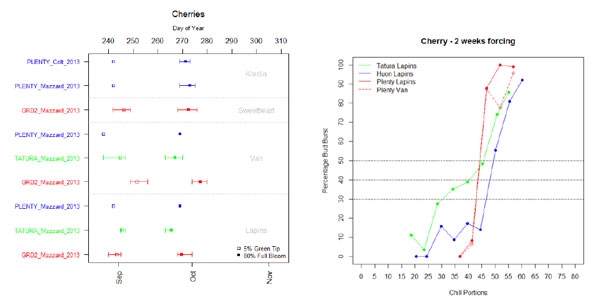End of dormancy (continued from last month)
Ok, so buds are doing things in their sleep, but how do we know when they wake up, when dormancy ends?
We can measure bud swelling and measure bud burst, but again, are these visible bud signs indicators that sufficient chill has accumulated?
To answer this question we need to remember that to break dormancy sufficient chill is needed AND a subsequent period of heat.
It could be that buds have reached their chill requirement much earlier and have just been waiting for the right amount of heat (like staying in bed until the sun comes out!).
Exploring a new model
While we know that breaking of dormancy is temperature dependant, current models do not take into account the timing and amount of heat required.
And it seems the two requirements are not independent.
A new model being explored looks at this chill/heat overlap and appears to better predict timing of budburst than the chill only models.
In this new model more chill accumulated in excess of the chill requirement (‘over chill’) lowers the amount of heat needed to reach bud burst. This might explain why the project found that bud burst and flowering in Tasmanian regions occurred in a condensed period compared to a longer period in Western Australia.
Figure 2 shows that bud burst for all varieties assessed occurred within a short time frame in Tasmania (Plenty), but over a longer period for Victoria (Tatura) and Western Australia (GRD2).
Chill requirement for normal flowering
If climates are changing, and warmer temperatures are expected, then knowing the chill requirement for normal flowering is important.
This knowledge will be valuable in the selection of the appropriate varieties and to avoid losses caused by having the wrong variety.
But to confuse us more, the amount of winter chill required differs by variety. Varieties are generally known to have low, medium or high chill, but this sort of classification is not adequate to help predict performance under a changing climate.
Some studies have quantified variety specific chill, but often only in chill hours, and we now know that there is no conversion from chill hours to chill portions because of how they are measured.
And we know that measuring chill in the field does not give the minimum chill requirement, only that the required chill has been met somewhere along the way.
Controlled environment forcing experiments
So determining minimum chilling requirements requires large-scale controlled-forcing experiments, and estimates are thus often unavailable.
This project has undertaken controlled environment forcing experiments to provide information about Lapins, one of the most commonly grown varieties throughout Australia.
The first year showed that Lapins from different sites had all reached 50% bud burst by 50 CP (Figure 4). A second year of experiments is underway using sites from Tas, Vic and WA.
Accumulating sufficient chill
(continued next month)
See this article in Tree Fruit Nov 2015






















